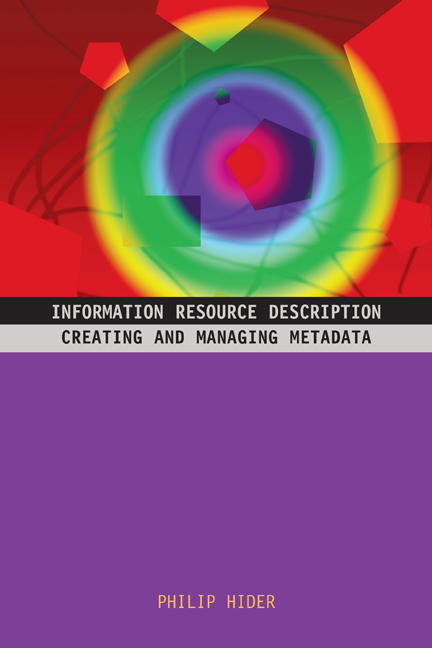Book contents
- Frontmatter
- Dedication
- Contents
- List of figures and tables
- Preface
- Abbreviations
- 1 Definitions and scope
- 2 Information resource attributes
- 3 Tools and systems
- 4 Metadata sources
- 5 Metadata quality
- 6 Sharing metadata
- 7 Metadata standards
- 8 Vocabularies
- 9 The future of metadata
- Further reading
- Metatadata standards
- Index
- Frontmatter
- Dedication
- Contents
- List of figures and tables
- Preface
- Abbreviations
- 1 Definitions and scope
- 2 Information resource attributes
- 3 Tools and systems
- 4 Metadata sources
- 5 Metadata quality
- 6 Sharing metadata
- 7 Metadata standards
- 8 Vocabularies
- 9 The future of metadata
- Further reading
- Metatadata standards
- Index
Summary
Introduction
Information retrieval systems can use metadata only if it is available. People or computers first have to create it. Some metadata is created along with the resources it describes; other metadata is created after the resources have been created and disseminated, by intermediaries or even by the end-users themselves. An information resource description may include metadata from several different sources, directly or indirectly. In this chapter we shall look at various kinds of metadata creator, and their motives.
Resource creators
It is generally in the interests of the creator of an information resource to provide some basic metadata at the point of creation. Often this forms an integral part of the resource. Its location may be governed by convention. For example, a title is normally included at the top of a manuscript, or on its own title page, or at the bottom of an art work, or at the beginning of a film and so on. In many instances, one might expect the creator to record their name, a title and perhaps a date of creation. They may also include some metadata pertaining to components of the resource, such as headings and page numbers.
In most cases, creators produce information resources, and their associated metadata, intentionally. However, this is not always the case. For instance, a document in an archive might have originally been created as a memo from one official to another but, once deposited in the archive, it becomes a record of this communication, with a different function from that of the original document. Nevertheless, metadata included by the memo's author (e.g. its date) may still be useful.
Computers and the internet have made it far easier for people to disseminate metadata as well as information resources. Desktop publishing applications allow them to tag (i.e. label) titles and other metadata elements included in the text of a web page, or to embed metadata in a document by inserting meta tags (see the section on mark-up languages in Chapter 7). As creators of resource carriers, computers can, of course, also add metadata themselves (e.g. file size).
Although many digital resources are created with minimal amounts of metadata, standards have been established for resource creators to apply, should they choose, or be required, to do so. For example, many academic journals stipulate that authors include, as part of their submissions, abstracts and keywords, as well as titles.
- Type
- Chapter
- Information
- Information Resource DescriptionCreating and managing metadata, pp. 59 - 76Publisher: FacetPrint publication year: 2012



